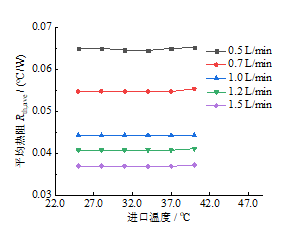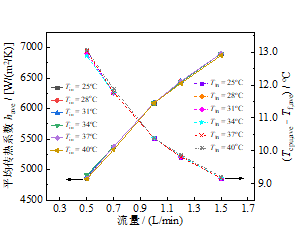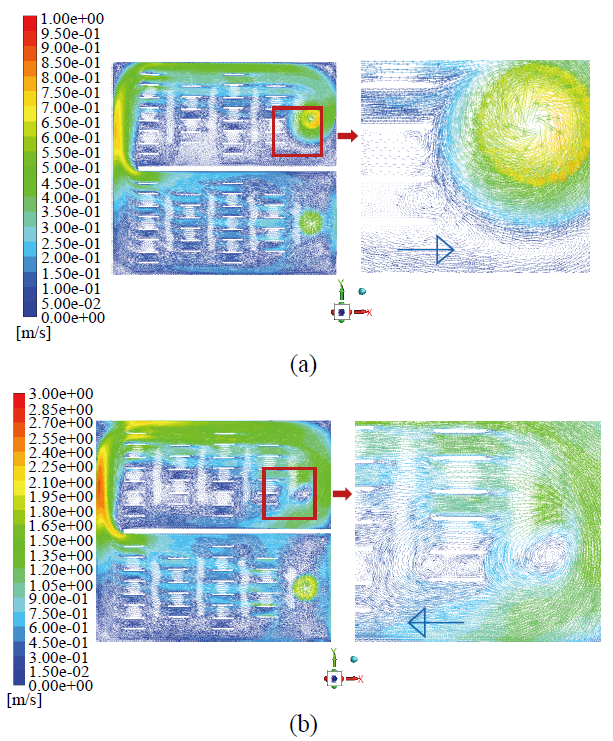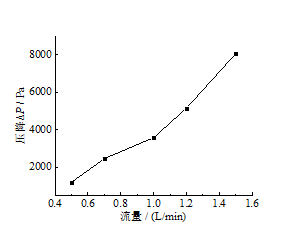0 引言
1 研究方法
1.1 模型简述
Fig. 1 (a) Schematic diagram of liquid cooling plate with hollow-fin; (b) sectional diagram of hollow staggered fins; (c) hollow staggered fin layout图1 (a)扰流空心翅片式微流道液冷板结构图;(b)空心交错翅片局部截面图;(c)空心交错翅片布置图 |
Table 1 Structure parameters of liquid cooling plate with hollow-fin表1 扰流空心翅片式微流道液冷板结构参数 |
| 参数 | 尺寸 / mm |
|---|---|
| Hc | 3.0 |
| Wc | 2.7 |
| Hf | 2.7 |
| Wf | 2.7 |
| Hi | 2.4 |
| Wi | 2.1 |
| Lc | 5.0 |
| Lf | 5.0 |
1.2 数学模型及求解方法
1.3 参数设置和网格独立性验证
Table 2 Thermophysical properties of materials表2 材料热物性参数 |
| 材料 | 密度ρ / (kg/m3) | 比热容cp / [J/(kg∙K)] | 导热系数k / [W/(m∙K)] |
|---|---|---|---|
| 铜 | 8 933 | 385.0 | 401.0 |
| 硅 | 2 329 | 712.0 | 148.0 |
| 去离子水 | 997 | 4 178.5 | 0.6 |
Table 3 Average temperature of CPU with different number of grids表3 不同网格数时CPU的平均温度 |
| 网格系统 | 网格数 | CPU的平均温度${{T}_{cpu,ave}}$/ ℃ |
|---|---|---|
| I | 3 657 958 | 317.90 |
| II | 2 044 022 | 317.66 |
| III | 1 272 375 | 317.39 |
2 结果和讨论
2.1 温度不均匀性
Fig. 2 (a) Relationship between temperature un-uniformity coefficient and inlet velocity; (b) relationship between temperature un-uniformity coefficient improvement and inlet temperature图2 (a)温度不均匀系数与进口流量的关系;(b)温度不均匀系数改善效果与进口温度的关系 |
2.2 液冷板的平均热阻
Fig. 3 Comparison of average thermal resistance at different inlet temperature and flow rates图 3 不同进口温度和流量下平均热阻比较 |
2.3 液冷板的平均传热系数
Fig. 4 Comparison of have and Tcpu,ave - Tf,ave of liquid cooling plate at different inlet flow rates and inlet temperature图 4 不同进口流量和温度下液冷板的平均传热系数和换热温差比较 |
2.4 流动特性
Fig. 5 Fluid area velocity vector diagram: (a) flow rate Qv = 0.5 L/min; (b) flow rate Qv = 1.7 L/min图 5 流体区域速度矢量图:(a)流量Qv = 0.5 L/min;(b)流量Qv = 1.7 L/min |
Fig. 6 Pressure drop comparison of liquid cooling plate at different inlet flow rates图6 不同进口流量下液冷板的压降比较 |










